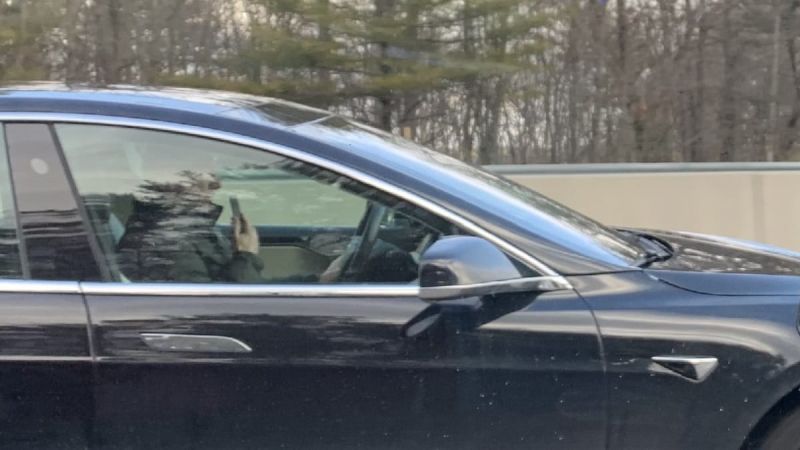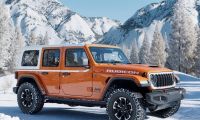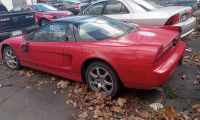It’s been five years this week since Joshua Brown was killed in his Tesla. The vehicle failed to stop before hitting a slow-moving semi-trailer that pulled across the Tesla’s path. Following the tragic loss of life, the media and the commenters under stories seemed to focus on which children’s program the occupant may or may not have been watching when he was killed. Shouldn’t we have been asking why the vehicle’s automatic emergency braking system didn’t stop the vehicle?
Related Story (New York Times): As U.S. Investigates Fatal Tesla Crash, Company Defends Autopilot System
Tesla Crashes Into Stationary Vehicles
Since that first fatal accident, Tesla vehicles have been involved in a number of odd crashes that seem entirely preventable, whether or not the occupant is actively or attentively engaged in driving. Many of the crashes were into large, obvious, stopped, or slow-moving objects. Firetrucks stopped at accident scenes. A concrete highway divider. Police vehicles stopped in the break-down lane. First responder vehicles with lights flashing and reflective tape all over them. Sometimes combined with flares deployed to warn approaching vehicles of danger.
Related Story (CNBC): Tesla faces another NHTSA investigation after fatal driverless crash in Spring, Texas
Why Don't Teslas Auto-Brake?
Why do Tesla’s vehicles fail to stop themselves? Why do Tesla vehicles fail to maintain their lane and hit vehicles parked to the right of the travel lanes? Shouldn’t the vehicle’s emergency braking system detect the large, flashy object ahead and slow down or stop prior to hitting it? Shouldn’t the Tesla’s lane departure warning and assist system jar the driver’s senses with flashing lights and warning sounds before it drifted out of its lane? Shouldn’t Tesla’s roadway departure mitigation system steer the vehicle back to the center of the lane? Why didn’t these common safety systems intervene and prevent the crashes?
Related Story (2014): Deaths in Tesla Model S crash might have been prevented by common safety system
Tesla's Driver-Assist Products
Tesla presents itself as a high-technology company leading the world in advanced driver assist systems. The company chose catchy phrases to describe these systems that imply the vehicles can “drive themselves.” Tesla also claims that its cars with these systems (now standard) have a "...10 times lower chance of accident than average vehicle..." If this is true, or even somewhat true, then why doesn’t Tesla have the ability to make its cars see the large unmoving fist responder vehicles, or simply keep the vehicle in the lane? It seems that Tesla must possess this capability or how could the vehicles operate without a driver steering like we have seen Elon Musk demonstrate in interviews? How can the owners post up videos of the vehicles they own navigating and driving along with no driver inputs if Tesla's vehicles can’t see the largest intentionally visible objects on the road, or maintain the lane they are in? Other vehicle brands we test do all of these things routinely.
Recent Tesla Crash Fatalities
The most recent questions come from a double fatality. By all reports, the vehicle had no occupant in the driver’s seat. Why didn’t the vehicle stop itself if this was the case? Is there no driver’s seat occupancy sensor? That question was answered by Consumer Reports who demonstrated that there isn’t. This should be no surprise because the Tesla summon feature allows the vehicle to drive short distances with no occupant. In a nutshell, Tesla's vehicles were designed to operate with no occupant.
Having tested vehicles from multiple brands with over-sensitive lane-keeping assist as well as vehicles that detected an impending crash and stopped our vehicle at highway speeds, the fact that Tesla cars hit things that are not moving makes us wonder what’s really going on.
If you are a Tesla owner, can you explain why an advanced vehicle would not stop before hitting a stationary vehicle ahead of it? How do you square this inability with Tesla’s driver-assist systems named to imply the cars can self-drive? Is it OK with you that Teslas can operate without an attentive driver or drift out of their lane into a police vehicle parked to assist a motorist? Help us understand why these things are OK from a car company that bills itself as a safety leader.
Since the accident that killed Joshua Brown five years ago, another accident with almost identical circumstances has recently happened. After the first, second, and third time a Tesla smashed straight into a parked first responder vehicle, more crashes of that type occurred. One Tesla managed to hit not one, but TWO parked emergency vehicles. Why hasn't the "problem" been identified and corrected?
On the five-year anniversary of the death of a passionate Tesla owner and advocate, it’s worth asking some hard questions. Tesla investors, fans, and owners should be the ones demanding answers the loudest.
The list of hard to explain Tesla vehicle crashes below provides some background on the types of crashes we describe in our story for those who may need the backstory.
April 2021: Video of Tesla Model Y On Autopilot With No Driver Demonstrates Need For Government Intervention
March 2021: Another Tesla Hits Another Semi From the Side - This Time It Looks Like a Model Y
August 2020: Tesla Operated By Full Self Crashing System Hits Two Parked First Responder Vehicles - Again
July 2020 - Police: Tesla On Autopilot Hits Not One, But TWO Parked First Responder Vehicles
January 2020: Second Crash In One Month Of A Tesla Into A Parked Firetruck Results In Fatality
December 2019: Tesla Model 3 On Autopilot Hits Yet Another Police Vehicle - Why Won't They Stop?
August 2018: Third Tesla Crashes Into Back of Firetruck - That's Four Crashes Into Emergency Vehicles This Year
May 2018: Another Tesla On Autopilot Hits Another Emergency Vehicle - You Can't Make This Stuff Up
January 2018: Tesla Police Blotter News - Tesla Driver Hits Parked Firetruck - Blames Autopilot
July 2016: Understanding the fatal Tesla accident on Autopilot and the NHTSA probe
John Goreham is a long-time New England Motor Press Association member and recovering engineer. Following his engineering program, John also completed a marketing program at Northeastern University and worked with automotive component manufacturers. In addition to Torque News, John's work has appeared in print in dozens of American newspapers and he provides reviews to many vehicle shopping sites. You can follow John on Twitter, and view his credentials at Linkedin












Comments
Author doesn't mention that
Permalink
Author doesn't mention that other cars with automatic emergency braking systems have crashed resulting in more deaths per mile driven than Teslas. No one can stop bad behavior like climbing out of the driver's seat while on a country road or not paying attention while driving on a highway at high speed when a stationary vehicle suddenly appears. But Tesla's safety record is better than any other vehicle currently on the road.
Help us make the story better
Permalink
In reply to Author doesn't mention that by bdflood (not verified)
Help us make the story better. Post a link to the safety data that you refer to showing that Tesla's vehicles are those with the lowest driver death rates. We will review it and include it in the story. The latest data we have from NHTSA and IIHS does not list a Tesla in the top 20 models with the lowest driver death rates. Here is the link: https://www.iihs.org/ratings/driver-death-rates-by-make-and-model
I believe I can answer your
Permalink
I believe I can answer your question. The reason you might not use the radar unit such as the one built into Teslas for initiating an emergency stop is the danger of a false positives. Imagine, for example, how bad the consequences would be if the safety system on the car slammed on the brakes every time there was a pop can on the road. One way of preventing this type of false positive accident is to calculate the speed of the detected object relative to the ground and only stop for objects that are moving more than X MPH. Viewed in this way, the radar unit is mostly there to prevent collisions with other moving vehicles. Tesla believes the natural solution here is to use cameras and neutral nets, like people do, but for now the human behind the wheel is still responsible for preventing this type of accident.
Thanks for taking the time to
Permalink
In reply to I believe I can answer your by Walter Stuermer (not verified)
Thanks for taking the time to consider the issue, Walter, and for your thoughtful response. I do agree that the danger of false positives is real and it is an important part of how emergency braking systems are designed. However, Tesla already has automatic emergency braking systems on all of the vehicles it sells now. As do all other brands. Many use both radar and optical sensors. Similarly, every brand has lane departure alerts and lane departure mitigation systems in their cars. Why are Tesla's existing systems not working to prevent these accidents? Tesla has chosen to push the issue of driver-assist technology forward, and using the term "Full self-driving" is just one example of the company's intent and its product offering. No car can self-drive, in any meaningful way, full or otherwise, without being able to detect and stop ahead of a parked firetruck or a massive semi-trailer across its path. Or stop itself from drifting out of its lane on the highway. Tesla has FSD on vehicles now and says that all of its modern models for sale have the needed equipment to make it work. Why has Tesla opted not to employ it to stop these preventable accidents? The human behind the wheel was relieved of full responsibility when ABS, traction control, and stability control became standard equipment. Still, it seems obvious that the occupants in the Teslas that slammed into these static objects would have responded to alerts of the coming danger. Why didn't the systems alert, and why didn't they take action if the unresponsive driver ignored them? Like the systems in all other brands vehicles do? Shouldn't Telsa's be held to the same standards as other carmakers' when it comes to safety, or perhaps a higher standard given Tesla's choice to advocate for what it calls self-driving vehicles?
I share your belief that self
Permalink
In reply to Thanks for taking the time to by John Goreham
I share your belief that self-driving requires that the vehicle to avoid collisions with stationary objects. It is my understanding that Tesla's automatic braking system does not yet do this for the reasons I have given previously. I would be quite surprised if other manufactures deviated from this due to the risk associated with false positives. Autobraking can still prevent thousands of accidents regardless how the system responds to stationary objects.
Why don't we hear about this type of accident happening with other brands of cars equipped with automatic braking? Note that what I'm about to write here is speculation: 1) Numbers. Every Tesla has automatic braking as part of the Autopilot or Autopilot-FSD system. So there are probably more Teslas with autobraking than any other brand of vehicle. 2) Publicity. For whatever reason, everything that has to do with Tesla gets 1000% more news coverage than any other brand. 3) Drivers who foolishly assume that the Autopilot is a self-driving system. Autopilot is not a self-driving system. But Autopilot-FSD may eventually become one, presumably by using cameras and Tesla's neural net chips.
I have chosen not to answer your other questions about lane departure, etc because I don't believe I know anything helpful regarding these topics.
You make good points. It will
Permalink
In reply to I share your belief that self by Walter Stuermer (not verified)
You make good points. It will be interesting to see if the crashes stop as technology changes and improves.
Why is this article all about
Permalink
Why is this article all about Tesla? Automobile accidents and safety equipment is not an issue with just one car brand. This is especially important seeing that overall the safety, accident, injury and death numbers are LOWER in Tesla's than other similar cars on average. So why not highlight ALL of the other cars that are not as safe as Teslas are?
Help make the story better.
Permalink
In reply to Why is this article all about by DeanMcManis (not verified)
Help make the story better. Post up a link with data that shows Tesla's injury, accident, and death numbers are lower than its peers. I will review the data and include it in the story. This story focuses on Tesla because it markets a product called "Full Self Driving," and thus, must have the ability to stop a car from crashing into stationary objects.
Another fatal Tesla autopilot
Permalink
Another fatal Tesla autopilot crash in California a couple days ago. Almost killed 2 others.